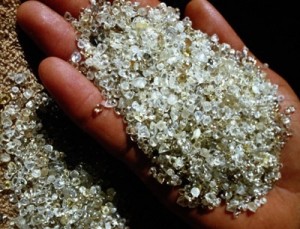 Wide-spread information has been circulated through various medias globally during the recent years about the so called worsening condition of Zimbabwe’s diamond sector, final among them is the closing down of Murowa mine, located in the country’s Midlands.
Wide-spread information has been circulated through various medias globally during the recent years about the so called worsening condition of Zimbabwe’s diamond sector, final among them is the closing down of Murowa mine, located in the country’s Midlands.
This is despite the fact that Zimbabwe has expansive reserves of diamonds, especially in the Marange fields, that it had capacity to supply 25% of diamonds traded globally. The question is who is responsible for the present deteriorating situation of the country’s diamond sector?
Much was expected from the diamond mining business in Marange a few years ago, giving hope that revenue from the stones would support many obligations of the Zimbabwe government but the inflows suddenly dropped when alluvial diamonds mined out leaving Treasury in a difficult position. Rio Tinto plc which held 78% interest in Murowa Diamonds, had sold its entire stake in June 2015 because of the ‘unfavorable tax policies of the government’.
The closure of Murowa is considered as a blow to the Zimbabwean diamond industry which is already ailing due to the downturn in global mineral prices. The situation has also not been helped by the Zimbabwe government’s new policy to merge the country’s seven mines into one consolidated mining Company, with the state taking a 50% stake. The government claims that this move is to improve transparency and efficiency in the mining industry, which has indeed suffered from ‘mismanagement and corruption’.
The consolidation was necessary because, as the Mines and Mining Development Minister Mr. Walter Chidhakwa says, “Mining companies have misrepresented their investment plans to the Government. They did not invest the amount of capital they agreed on with Government when the parties signed the joint ventures. Lack of sufficient fund investments in exploration to extend life of mines through discovering new deposits to maintain operations have seen surface gems mining out. This has caused revenue from their mining activities, in which Government has 50% stake, to plunge drastically.”
But the mining companies are strongly opposing the governmental move of the consolidation plan under which the government would have 50% in Zimbabwe Consolidation Diamond Corporation (ZCDC), while other players would proportionally share among themselves the remaining 50% stake. Sources say that pressure and threats by government have created fear among the miners, forcing them to come to the negotiating table.
The Government sources on the other hand reveal that some miners are opposed the consolidation scheme because of the tight monitoring systems it comes with. They say, earlier the individual company had a bigger opportunity to loot the diamonds.”
On the other hand, a report published in ‘The Zimbabwean’ reveals that the diamond sector is not flourishing because the government has allowed military people to pose themselves as miners in Marange.
Mr. Farai Maguwu, Director of the Centre for Natural Resources Governance says, “The Marange diamond sector is run by the Chinese, army generals and Central Intelligence Operatives (CIO). Marange diamond fields are full of corruption from beginning to end. Many of the companies in Chiadzwa are just shelf companies which do not have any track record in mining. As they are not miners, they have not invested in anything. On the contrary, they harvested in everything.”
Various news reports from global media indicate that the alluvial diamonds in Zimbabwe have run out. There are, however, symptoms which prove that the country is extremely rich in kimberlites, but the capital required to mine those stones is much greater than with alluvial diamonds. So the observers feel companies are hesitant to invest, because of the difficulty of doing business with the Zimbabwe government.
Posted by Suresh Chotai



